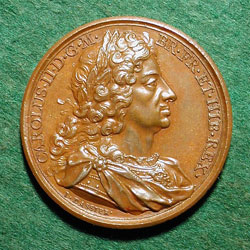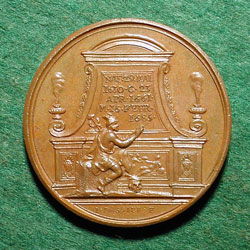

|
CHARLES II |
|
|
Charles II (1630-1685), king of England, Scotland, and Ireland (1660-1685) was the second, but eldest surviving, son of King Charles I. He held a nominal military command in the early campaigns of the first civil war of the English Revolution but later fled from England and went into exile at The Hague, the Netherlands. On the execution of Charles I in 1649, Charles II assumed the title of king. Soon thereafter he invaded England but his army was routed by Oliver Cromwell and Charles fled to France. In 1658, following the death of Cromwell, the demand for the restoration of royalty increased. In 1660, his army invaded London and forced the Parliament to dissolve. In the Declaration of Breda, Charles announced his intention to accept a parliamentary government and to grant amnesty to his political opponents. A new Parliament requested Charles to return and proclaimed him king on May 8, 1660. Charles’ reign marked a period of relative stability after the upheaval of the English Revolution. Nevertheless, the chronic mismanagement of the English finances forced him into a secret alliance with Louis XIV of France in a war against the Netherlands. This, together with his efforts to become an absolute ruler, brought Charles into conflict with Parliament. The struggle was heightened by enactment of the anti-Catholic Test Acts and by the so-called popish plot fabricated by Titus Oates. Charles died on February 6, 1685. He was succeeded by his brother James II. (Microsoft Encarta Online Encyclopedia 2002). LINK to the
Popish Plot (from dialspace) |
|